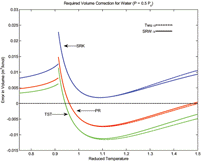Improving Volumetric PVTxi Property Models with Volume Translation
Researcher: Kurt Frey
Principal Investigator: Professor Jefferson Tester
 Process simulation is a powerful tool for the design, construction, and maintenance of reaction and separation systems. However, the accuracy of property models has not kept pace with current demands in the chemical process and petroleum industries. Systems that include light gaseous components in highly non-ideal or polar solutions are commonly encountered and will become even more prevalent as industry looks to develop more non-conventional hydrocarbon fuel sources. Mixtures involving hydrogen, methane, carbon dioxide, ethanol, and water along with the light alkanes will form the bulk of fuel processing for the foreseeable future.
Process simulation is a powerful tool for the design, construction, and maintenance of reaction and separation systems. However, the accuracy of property models has not kept pace with current demands in the chemical process and petroleum industries. Systems that include light gaseous components in highly non-ideal or polar solutions are commonly encountered and will become even more prevalent as industry looks to develop more non-conventional hydrocarbon fuel sources. Mixtures involving hydrogen, methane, carbon dioxide, ethanol, and water along with the light alkanes will form the bulk of fuel processing for the foreseeable future.
Current state-of-the-art property models rely on volumetric relations like the Peng-Robinson or Redlich-Kwong-Soave equations, which have remained largely unchanged for the last thirty years. While this persistence is a testament to the robustness of these models, there is still a pressing need for improvement. Errors of more than five percent in the enthalpy and more than twenty percent in the liquid volume are common particularly in the compressed fluid regions at extreme conditions of pressure and/or temperature. Such errors are unacceptable when a margin of only a few percent can dictate the feasibility of a process. Most changes to property models have been incremental and are often the result of regression of large sets of data. Regression with multiple parameters is very accurate for systems where sufficient data are available, but inevitably is inadequate because data over a full range of interest will never be realized.
This project aims to characterize the models that best represent PVTxi relations and the ability to successfully predict phase coexistence using a minimum amount of experimental data. A complete understanding of the relationship between model parameters and data representation will help guide experimental design so measurements will have the greatest utility for property representation.